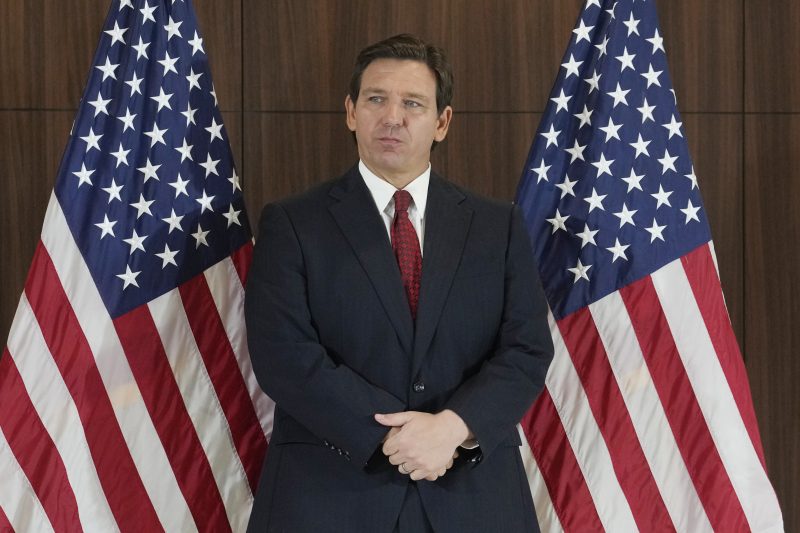Technically, the only candidate for the Republican presidential nomination in 2024 is the same guy the party nominated in each of the last two contests: Donald Trump.
But the line between “actual declared candidate” and “person very obviously running for the position” is drawn in only the lightest pencil, so we have a decent sense of what the field might end up looking like. Former U.N. ambassador Nikki Haley, for example, is understood to be planning an announcement next week. Trump’s vice president, Mike Pence, is doing all the things future candidates do before they become candidates.
Then there’s Florida Gov. Ron DeSantis. DeSantis is not yet a candidate, officially, having just closed out his reelection campaign three months ago. There’s little question that he plans to announce a bid, though, and little reason for him not to. In polling, including a survey released by Monmouth University on Thursday, DeSantis is the only candidate within shouting distance of Trump. In fact, in Monmouth’s poll, they’re tied in a head-to-head contest.
This is the scenario that most observers expect could lead to Trump’s defeat in next year’s primaries. A field with a number of options but only one who serves as the primary anti-Trump candidate. The question, then, is whether DeSantis can preserve that position until the voting begins.
That’s related to another, equally important question: Can DeSantis weather the storm of attacks that has already started to form?
These questions emerge from the Monmouth poll. Before we dig into it, by the way, we should contextualize it. There are a lot of polls focused on the 2024 Republican nominating fight out there, many of them from unproven or lesser-known pollsters. The position of Trump and DeSantis in those polls varies, both in questions that consider a wide field of candidates and in ones that position Trump and DeSantis against one another directly. So understand that Monmouth’s results — from a well-known and well-respected pollster, mind you — may vary from other results.
What’s interesting, though, is how the poll positions Trump and DeSantis against each other. For example, the most recent Monmouth poll shows Trump and DeSantis even at 33 percent support, but that’s a marked improvement for Trump since December. Then, DeSantis led by double digits, with Trump running even with “don’t know.” Now, he and the Florida governor are in the same place.
Why? Margins of error play some role here, certainly; the margin of error in the December poll was 5.2 points and in the more recent one 6.1 percent. That makes the shifts since December not statistically significant, however large they look.
Of course, there have also been changes in Republican politics since December. Then, the party had just underperformed expectations in the midterm elections, a disappointment for which Trump received a fair amount of blame. In Florida, though, DeSantis won reelection easily. In the months since, the sting of the midterms has faded and Republicans have taken control of the House.
So let’s consider another question Monmouth asked: If the contest were only between Trump and DeSantis, who would Republican primary voters support? The answer was DeSantis, who surged over 50 percent. When the question was narrowed to a head-to-head choice, DeSantis gained 20 points and Trump only seven.
This is the reason for our first question above. If DeSantis can keep the primary as a mostly head-to-head contest, either through luck (people deciding not to run) or strength (making other potential candidates rethink running), he’s in much better shape. After all, some of the DeSantis support in the head-to-head contest are simply anti-Trump voters, people who will support anyone who isn’t the former president.
Monmouth’s polling shows that this pro-DeSantis and/or anti-Trump vote spreads throughout the voting base. Trump fares better with his traditional base: voters without college degrees and older voters. DeSantis does better with independents who lean Republican than with strong partisans, presumably a less Trump-loyal group (and one that overlaps with younger voters, it’s safe to assume). Both candidates run about even with evangelicals, as The Washington Post has reported.
This is all being measured before DeSantis is a candidate, meaning before he has been a direct target of a lot of friendly fire. To date, he’s managed to both become well-known in the party and to keep the percentage of Republicans who view him unfavorably low. More than twice as many Republican primary voters view Trump unfavorably as view DeSantis that way, even after you consider only the percentage of unfavorable opinions among those with an opinion. (Pence is viewed much more unfavorably than either.)
Can that hold? Often, candidates hope for an opponent like Haley, someone for whom most people haven’t formed an opinion. That allows them to define their opponent, often negatively. For all of the firebombs Trump’s thrown this week at DeSantis, the governor is already well-defined; 86 percent of Republicans have an opinion of him, mostly positive. Undoing that will be tricky. In April 2015, by contrast, no Republican candidate had the level of familiarity that DeSantis has now — much less the top-line favorability rating.
How important is this favorability rating issue? Well, Monmouth also did a head-to-head matchup between Trump and Sen. Ted Cruz (R-Tex.). Trump beats Cruz easily — and Cruz’s unfavorable numbers are not that much lower than the former president’s.
So that’s the path forward for DeSantis at the moment. Keep those unfavorables down and keep people out of the race. And that’s the path for Trump, too: embrace a wide field and do your best to set DeSantis’s reputation on fire.
That latter goal, it’s safe to say, is in Trump’s wheelhouse.

